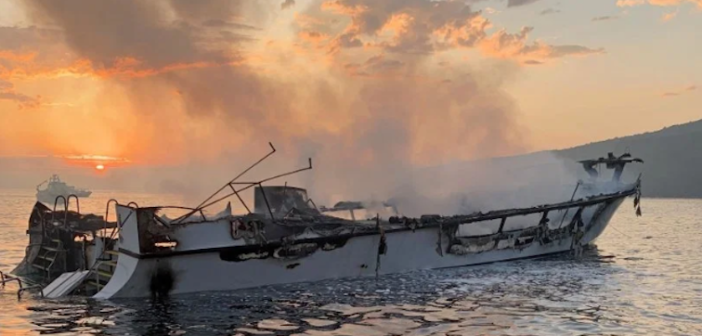Crewmembers told investigators that they had not participated in a fire drill aboard the dive boat Conception and one said he saw sparks when he recharged his cell phone just before the fatal fire that killed 33 passengers and one crew, National Transportation Safety Board (NTSB) documents released Wednesday show.
The 104 entries in the docket range from reports and witness interviews to the Certificate of Inspection (COI) for the 75'x25' wooden hulled boat built in 1981 that burned to the waterline and sank in about 60' of water off Santa Cruz Island, Calif., Sept. 2, 2019.
“A member of the vessel's crew shall be designated by the master as a roving patrol at all times, whether or not the vessel is underway, when the passenger's bunks are occupied,” the COI says. All six crewmembers were asleep, the NTSB said.
The docket does not include a probable cause, analysis or recommendations, which will be announced at an Oct. 20, 9:30 a.m. NTSB board meeting to be webcast only. (A link will be available shortly before the start of the meeting.)
The NTSB’s detailed report notes that divers’ electronics such as underwater flashlights and cameras were stowed on tables in the salon. “Because the devices had just come out of the water, they were wet when they were set on the tables,” a crewmember recalled. Some of the devices as well as cell phones and tablets were plugged in to recharge via outlets. “The first deckhand said that it was not uncommon to have batteries charging next to camera equipment that was still drying after a dive,” said the report by
Andrew Ehlers, NTSB’s marine accident investigator. “Crewmembers remembered that, on the accident voyage, at least one passenger-owned power strip was being used to recharge the electronics.”
A Coast Guard safety bulletin issued right after the fire urged operators to make sure their vessels are safe. One major suggestion was to limit the unsupervised charging of lithium-ion batteries and extensive use of power strips and extension cords.
The bulletin urged mariners to “ensure crewmembers are aware of and clearly understand their obligations including any additional requirements detailed on the COI.” Emergency escapes should be clearly identified, functional and unobstructed.
The NTSB report in the docket also highlights crew training for fire emergencies. “New Subchapter T regulations also require the master of a small passenger vessel to ‘conduct sufficient fire drills to make sure that each crewmember is familiar with his or her duties,’” the report said. Three crewmembers said they hadn’t participated in a drill onboard the dive boat.
The Coast Guard has convened a rare Marine Board of Investigation into the accident, which also is being looked into by the FBI and the Bureau of Alcohol, Tobacco and Firearms (ATF) in consultation with the U.S. Attorney.
The NTSB said it may add additional material to the docket.




